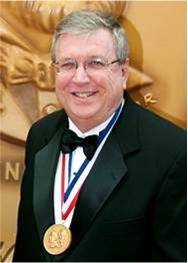Alumni Profile: Eric Fossum (PhD ’84)
Professor Eric Fossum (PhD ’84), 2018 recipient of the Yale Science & Engineering Association Award for Advancement of Basic and Applied Science, compares his work as an image sensor device physicist and engineer to solving a puzzle. “It’s like taking knots out of a ball of string,” Fossum said. “It’s helpful to have that background in physics and engineering and if you have experience, you know what things work and don’t work. Sometimes a new idea flashes in your head and suddenly you get the idea.”
Fossum was born in Simsbury, Connecticut and attended Trinity College from 1975 to 1979, earning a Bachelor of Science in Physics and Engineering. He worked for a computer company as a computer programmer throughout high school and college to pay for his education. He then attended Yale University for graduate school and earned a PhD in Engineering and Applied Science. Fossum immensely enjoyed working with the engineering school professors at Yale. He and other graduate students called themselves the “Ma-Barker gang” in reference to Fossum’s professors and mentors, Tso-Ping Ma and Richard C. Barker. “I’ve worked on image sensors my entire life,” Fossum said. “But Yale was the start of all that.”
In 1982, when Fossum was in his second year at Yale, he applied for the Howard Hughes Fellowship, through which he was able to spend the summer working for an aerospace company. He was exposed to infrared imaging devices for defense applications and became interested in exploring imaging devices for the rest of his graduate education. Fossum was interested not only in camera devices, but also in other imaging devices like the naked human eye. “Image capture devices are interesting,” Fossum said. “They combine physics and engineering—photons, light, optics, semiconductor devices and microelectronic circuits—and a whole camera system. You really get to work in many disciplines simultaneously. Instead of seeing waveforms on an oscilloscope, you get to see a picture from your work, which is rewarding.”
Currently, Fossum is a professor at Dartmouth and doing research on the Quanta Image Sensor (QIS), an innovative image sensor that has the potential to revamp the previous CMOS sensor and the entire camera system. This new type of camera chip is sensitive to single photons of light and, thus, could allow the user to capture light at the smallest possible level. This produces images of higher quality, even in situations of low light. The camera chip can detect electromagnetic energy and can now measure a million pixels, each one sensitive to a single photon of light. Fossum says the chip has far-reaching applications, from the visualization of distant objects in space to the capture of quality images in dim light for consumer use. He and his former PhD students are also currently working on Gigajot, a startup company based in Southern California, to commercialize QIS.
Beyond his research, Fossum has always had a natural passion for teaching, whether in science or other subjects. He taught while at Yale and immediately took a faculty position at Columbia University teaching electrical engineering after graduate school. He finds his current job as a professor at Dartmouth very rewarding and hopes that through his teaching, his students recognize that engineering and the liberal arts are more than learning equations and facts.
In his free time, Fossum likes to go out to his farm in New Hampshire where he is able to face other challenges and work directly on the task at hand. “You start with nothing and you get to create something out of it—you can see what you have done,” Fossum said. “When you work in science, you’re not always sure what you accomplished at the end of the day.”
With that being said, Fossum definitely has plenty to show for his work. In fact, the CMOS sensor’s success was due, in his opinion, to the multitude of uses that have emerged for it in contemporary society. Smartphone cameras that use CMOS sensors are used daily for recreational photography or to be shared through social media in capturing protests, social movements or as Fossum points out, acts of injustice such as the video recording of David Dao, the man being dragged off the United flight. “Now that there is a video recording of the circumstances, it changes your view of the incident,” Fossum said. “A person can get justice when that might not have happened without ubiquitous camera use.”

